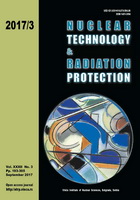
ANALYSIS OF THE WCLL EUROPEAN DEMO BLANKET CONCEPT IN TERMS OF ACTIVATION AND DECAY HEAT AFTER EXPOSURE TO NEUTRON IRRADIATION

Vol.
XXXII, No. 3, Pp. 193-305
September 2017
UDC 621.039+614.876:504.06
ISSN 1451-3994
Pages: 217-221
Authors: Gediminas Stankunas and Andrius TidikasAbstract
This comparative paper describes the activation and decay heat calculations for water-cooled lithium-lead performed part of the EURO fusion WPSAE programme and specifications in comparison to other European DEMO blanket concepts on the basis of using a three-dimensional neutronics calculation model. Results are provided for a range of decay times of interest for maintenance activities, safety and waste management assessments. The study revealed that water-cooled lithium-lead has the highest total decay heat at longer decay times in comparison to the helium-cooled design which has the lowest total decay heat. In addition, major nuclides were identified for water-cooled lithium-lead in W armour, Eurofer, and LiPb. In addition, great attention has been dedicated to the analysis of the decay heat and activity both from the different water-cooled lithium-lead blanket modules for the entire reactor and from each water-cooled lithium-lead blanket module separately. The neutron induced activation and decay heat at shutdown were calculated by the FISPACT code, using the neutron flux densities and spectra that were provided by the preceding MCNP neutron transport calculations.
Key words: Monte Carlo calculation, activation method, fusion, neutron irradiation
FULL PAPER IN PDF FORMAT (563 KB)